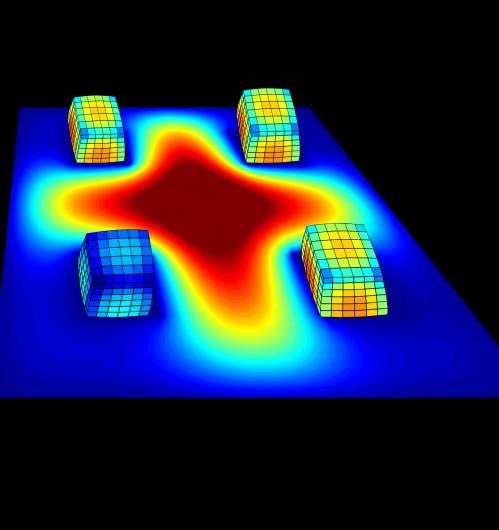Researchers uncover a synthetic material that rebuilds itself through chemical communication

(Phys.org)—Self-moving gels can give synthetic materials the ability to "act alive" and mimic primitive biological communication, University of Pittsburgh researchers have found.
In a paper published in the Jan. 8 print edition of the Proceedings of the National Academy of Sciences, the Pitt research team demonstrates that a synthetic system can reconfigure itself through a combination of chemical communication and interaction with light.
Anna Balazs, principal investigator of the study and Distinguished Professor of Chemical and Petroleum Engineering in Pitt's Swanson School of Engineering, has long studied the properties of the Belousov-Zhabotinsky (BZ) gel, a material first fabricated in the late 1990s and shown to pulsate in the absence of any external stimuli.
In a previous study, the Pitt team noticed that long pieces of gel attached to a surface by one end "bent" toward one another, almost as if they were trying to communicate by sending signals. This hint that "chatter" might be taking place led the team to detach the fixed ends of the gels and allow them to move freely.
Balazs and her team developed a 3-D gel model to test the effects of the chemical signaling and light on the material. They found that when the gel pieces were moved far apart, they would automatically come back together, exhibiting autochemotaxis—the ability to both emit and sense a chemical, and move in response to that signal.
"This study demonstrates the ability of a synthetic material to actually 'talk to itself' and follow out a given action or command, similar to such biological species as amoeba and termites," said Balazs. "Imagine a LEGO set that could by itself unsnap its parts and then put itself back together again in different shapes but also allow you to control those shapes through chemical reaction and light."
"We find this system to be extremely exciting and important because it provides a unique opportunity to study autochemotaxis in synthetic systems," said Olga Kuksenok, a member of the research team and research associate professor in the Swanson School's Department of Chemical Engineering.
More information: Reconfigurable assemblies of active, autochemotactic gels, Proceedings of the National Academy of Sciences. www.pnas.org/content/early/201 … 432110.full.pdf+html
Journal information: Proceedings of the National Academy of Sciences
Provided by University of Pittsburgh
















